Monday, October 31, 2011
I Cooked My Vises
A couple weeks ago I was traveling for a few days. And for once I had the foresight to get some things ready a couple days before my departure. One of the things on my list was to finish the wheels on my vises with baked flax oil.
So I stripped my bench at home of its two satin iron handwheels, dropped them off at my brother's home and left a note: "beautify my wheels."
By the time I got home a few days later, two baked-flax-oil handwheels were waiting for me.
And boy did they look fantastic. I couldn't wait to get them reinstalled on my bench. And last week I did just that.
The wheels look and feel fantastic, and are now highly rust resistant to boot. I don't know how your monitor is calibrated, so I'll try to give you an idea of how these look. I'd call the color "chocolate-bronze". But the chatoyance of the steel underneath is still visible. It almost looks like a cat's eye stone. Almost.
I'm not much for fancy benches, or flashy hardware. I like a more subdued, patina-esque look. These fit the bill perfectly.
We ship all vises now with handwheels detached, so you can bake your's too. Here's the details.
Categories
Glide Leg Vise,
Moxon Vise,
Personal Work,
Tail Vise
Saturday, October 29, 2011
The Three Essential Vises
1. The vise hardware is less expensive than our other vises.
2. We don't make a twin-screw vise for bench use (face vise position).
3. The Moxon vise works sweetly.
Before I get into the topic at hand, let me say the following. This is my personal opinion regarding workholding. It applies to how I work, and the furniture I build, which I think is typical of what most people build for their homes. Rectilinear forms that are suited to typical bench holding capabilities. If you make Maloof rockers, you have very special requirements. I'm not going to attempt to cover that here. Also, I am not a businessman. I'm a woodworker who happens to run a woodworking-related business. So my opinions here will not be offered to simply bolster a product or sales. That goes against our personal ethics here. We don't make anything that we ourselves do not use enthusiastically. I'm the most active woodworker here, and I use all of our products virtually every day.
I've been working wood seriously since my first (and only) year in college. I'm not exactly old (I'll be 38 in a couple months), but I do have about 20 years of working wood under my belt (along with the results of many rounds of southern fried chicken). My first bench was a cast off beauty-salon styling station (my two uncles were hair stylists and toupee makers, and no, I was never a client.) I removed the sink and plumbing, added a particle board top and vise, and stashed my grandfather's junk tools into the drawers on each side. I kept the giant mirror for a while, until I grew tired of glancing up after a mistake and seeing the humiliation on my face. It was a good way to keep me humble. This was also about the time my physique changed from resembling Clark Gable to not resembling Clark Gable. I walked the same path most do. Trashing or re-purposing a previous ultimate bench, and building another ultimate bench. This is how I got to where I am today. I have reached the point where I am completely satisfied with my bench, for how I work, and can say confidently that I will never wonder about building an even better bench in the future. If I do build another bench for myself, it will be nearly identical to the one I'm using now, including its three essential vises.
The Wagon Vise
I eliminated my moving-block tail vise some years ago in favor of a traditional wagon vise. I have not looked back. The simplicity of the wagon vise far outweighs the frustration that typical tail vises generate. And I can work on that end of the bench, just like any other area of the bench. I don't have to worry about sagging, I don't have move a large, heavy block of wood just to move a dog, and I don't have to treat that area of the bench like a scientific instrument. Wagon vises allow robust tops. Yes, I don't have an open jaw on that vise, but I haven't found the need for one yet. There are other ways to accomplish that rare task. Would you trade short term inconvenience for long-term frustration? For planing the faces of boards (and that's what this area gets used for 99% of the time) the wagon vise is the best, period. I should clarify this paragraph by adding that when I gave up on moving-block tail vises, nobody worth their salt was making decent hardware. Lie-Nielsen does now. I stand firm though in my opinion. Wagon vises are my preference.
The Leg Vise
I've used every type of face vise out there on a bench at one time or another. The leg vise is the best. Hands down. Why? Its grabs stock tenaciously with little effort or thought. Extremely frustrating is a vise that gives zero feedback on pressure--when you crank down (and you shouldn't need to "crank down"), do you know where your effort is directed? Is it overcoming the build-in resistance of the vise mechanism? Is the screw getting tighter on its split-nut, only to pop out at the last turn? Or is it going directly into holding your board against the front edge of the bench? Leg vises provide the latter. You are moving very little weight or mechanism when adjusting a leg vise, especially if you have a weight-support system like the Glide. You know exactly when the vise starts to grip your workpiece. The geometry of the vise also provides extreme, but controlled force. In other words, you don't have to think about operating the vise. I won't discuss having to adjust a pin. It's not an issue for me or our customers. Simply put, having to reposition the pin allows great simplicity of design for the rest of the vise components, guaranteeing consistent performance. Again, would you exchange short term inconvenience for long term frustration?
The Moxon Vise
Here's where the argument for the leg vise really comes into play. With the repopularization of the Moxon vise, the twin-screw face vise becomes obsolete. Why? Twin-screw face vises excel at one task: holding boards between screws for working ends. They do not hold boards well above the screws for working edges, because the vise has no fulcrum or pivot point below the screws to balance the thickness of the stock. The vise racks every time. It can't hold work positively and securely with minimal effort. It's like using two leg vises, only you've eliminated the length advantage of the chop, and the fulcrum of the parallel guide and pin. Only when you place a board between screws, where the chop can clamp down on material equally both above and below the screws, do you get excellent workholding. So in building typical, rectilinear furniture when do we need to vertically work the ends of boards? Primarily when dovetailing or tenoning. And both of these sawing tasks are best accomplished with the workpiece in a raised position, above your planing bench height by about 6" or so. The Moxon vise raises your workpiece to this height. A twin-screw vise as a face vise forces you to bend over to dovetail or tenon, and it falls short for typical face vise tasks like planing edges of boards. In my opinion, the Moxon vise completely eliminates the need for a twin-screw face vise.
So back to the original question: will you be offering a twin-screw face vise? or can I use your Moxon hardware as a face vise in my bench?
In my opinion the utility of the twin-screw rests entirely in holding work between screws, not above, and all of that work is best accomplished 6" above bench height. So mounting a Moxon on the front of a bench is inefficient, and counterproductive. You've eliminated the best aspect of the Moxon: raising work to a proper working height and holding it there securely. Plus, the vise capacity is only 2-1/4", more than enough for end work, but perhaps not enough for face vise work. Yes, we offer longer screws, but this is in the context of using the Moxon on top of a bench for a specific, infrequent use. You would not want to keep longer screws on this vise permanently in a face vise position. The only time I would mount a Moxon permanently would be in a dedicated bench, at "Moxon height". If you have room for this dedicated "joinery" bench, by all means mount a Moxon permanently on this bench.
In the end, yes you could use our Moxon hardware to build a limited capacity face vise. I just don't think its a choice you'll ultimately be happy with. If you're looking for an economical face vise, build a leg vise with a bench screw (Lie-Nielsen makes a nice one for $85) and use our Moxon vise in its best context on top of your bench.
Categories
Glide Leg Vise,
Moxon Vise,
Tail Vise,
Technical Questions
Tuesday, October 25, 2011
Andy Brownell's Moxon Vise
One of the people that we always look forward to seeing at WIA is Andy Brownell, known to many as the "Gorilla Glue Guy". And that, in our opinion, is an unfortunate moniker, since Andy is not simply a rep for Gorilla Glue. Every show we've been to, including a couple L-N events in Ohio, we expect to see Andy behind his bench most likely cutting dovetails by hand or fitting dozens of mortise and tenon joints. Andy brings his projects to shows, to the benefit of anyone who happens to visit the Gorilla Glue booth.
Andy is a great craftsman, with a technician's taste in joinery and a surgeon's skill with tools. He's spent time under the tutelage of another good friend of Benchcrafted, Jeff Miller. So its no wonder that Andy's work is eye-catching. He's also a gentleman, and enthusiastic about the craft, two qualities that we like.
Ironically enough, at WIA a few weeks ago we displayed a sign on our Moxon demo bench that stated "clamps to any surface, great for guerrilla joinery". One person the entire weekend picked up on that, and it was none other than Andy, the "Gorilla Glue" guy!
Andy bought a Moxon kit at the show, and sent us these pictures of his benchtop bench with Moxon hardware. The wood is Niangon, a west African species. The pic above is before finish was applied to the wood, or the hand wheels. Below shows the vise after a Danish oil finish, and baked tungoil on the hand wheels.
If you'd like to see more of Andy's work, please visit his page at Lumberjocks.
Saturday, October 22, 2011
Friday, October 21, 2011
Mag-Bloks For Tool Storage
Luthier Richard Wile has shared a blog post with us about how he used Mag-Bloks to store fine tools on the back edge of his bench. Using a standoff, he's created a slot behind the Mag-Blok to further increase storage space. Check out his entry here. Oh, if you scroll down that page, keep the drool of the blog please. Thanks.
On a related note, Christmas will be here before we all know it. We get backed up this time of year, despite our efforts to prepare. If you are looking for an excellent Christmas gift, you won't do better than a Mag-Blok. Everyone loves them.
Thursday, October 20, 2011
You Snooze You Loose
I'm a tad late on this post, so I do apologize. Next September I'll be teaching a class at Kelly Mehler's School of Woodworking in Berea, KY. We'll be building the Roubo bench. The class was just announced last week, and I had planned to post about it, but due to some travel I was unable to. Well, make a long story short, the class is already sold out. You can still join the wait list in case someone cancels, which does happen.
Monday, October 10, 2011
New Changes To Benchcrafted Vises
We've recently made a couple changes to both our Tail Vise and Glide Leg Vise.
Both vises now ship unassembled, in more compact boxes. Assembly is quick and easy. It will take maybe one minute to assemble your vise. Leaving the handwheels off the screws has allowed us to package the vises more securely, using less packing material. We're also wrapping almost everything in VCI paper to prevent corrosion. Customers will have less waste to dispose of. Some customers, depending on what they order, may also save on shipping, since we can now use some flat rate containers for certain orders.
The other advantage of shipping the vises unassembled is that you can apply treatments, such as baked flax oil to the handwheels before assembly. Stay tuned for a blog post on this in a couple weeks. I'm treating the hand wheels on my personal bench with baked flax oil.
The other changes we've made are to the Tail Vise's sliding plate assembly. The sliding plate is now universal. We've reconfigured the holes to allow the plate to be flipped over for right or left-hand use. So any Tail Vise can be assembled each way in just a few seconds. This has the distinct advantage of making ordering a piece of cake. It also means we don't need to stock both vises, which greatly decreases lead times. Speaking of which, these changes are all based on our short term goal of eliminating our lead times entirely. We're getting close.
The other change we've made to the plate is with the dog clearance hole. It's now square instead of round. We moved to a round hole a while back in order to accommodate a wider range of configurations, but after some scientific analysis we've decided that the square hole has a much cleaner look, and removes less material from the plate. It will of course accommodate round dogs, up to 1" dia. if you wish.
Here's a short video we prepared to show the assembly of the handwheel and the Tail Vise's sliding plate. The Glide isn't included in the video, but it assembles the exact same way.
We've updated our installation instructions for both vises to reflect the new changes, and included assembly instructions as well. Those instructions are available separately on our downloads page.
Categories
Glide Leg Vise,
New Products,
Tail Vise,
Technical Questions
Thursday, October 6, 2011
On The Horizon
So what is next on Benchcrafted's drawing board?
We get this question frequently.
We're usually pretty secretive about what we're planning, and that's not to protect our ideas so much as it's a defense mechanism to prevent embarrassing failures. Like these.
But last week at WIA we were pretty open about what's on the horizon. We placed the prototype right on our demo bench between our Glide Leg Vise and Tail Vise. And not a few attendees took notice. Ben from Ben's Brooklyn Build-It Blog at Tools for Working Wood (that's Ben's pic above, from his blog) wrote a short entry about the vise. By the way, if you haven't already, make sure to bookmark Ben's blog. It's worth following just for Ben's clever animated gif's.
The Royal Forge Carver's Vise is owned by Louis Bois (yes, that Louis Bois) who was with us this year in the Benchcrafted booth. Louis was kind enough to bring the vise from Canada just for the show. I should say also that Louis is of French heritage and speaks French fluently (his name is pronounced without the "s", and Bois is pronounced "Bwah".) A couple nights last week during WIA Louis and I stayed up late as I picked through his volumes of L'art Du Menuisier. I wonder how many people are lucky enough to have their own, personal Roubo translator? Thanks Louis.
The vise is a gorgeous piece of hardware, reminiscent of the classic tools you'd find in old engravings, like Roubo or Diderot. But the thing is, this vise isn't necessarily that old.
The vise was manufactured by the Royal Forge company in Paris sometime in the late 19th to early 20th century. The catalog page above is from a 1920's era version. We can't be exact on that number, but there is a telephone number in the front, so that's narrows it down somewhat. We've done a fair amount of late night Google Image searching, as well as perusing lots of on-line library photo records in search of a picture of the vise. Below is the only image we found.
Louis' vise jaws are lined with cork. It looks like the lady carver above is using a piece of leather to provide a fantastic grip on her delicate carving.
Aside from sculptural work, the vise would be useful for working parts with a spokeshave or drawknife, such as working chair parts. Not everyone has room for a shaving horse, and this vise could serve well for holding a variety of chair parts. Clamped to a bench, the vise would hold work at a convenient chest height. The late, great John Brown used a metal machinist's vise for a good portion of his workholding needs in building Welsh stick chairs. The wooden jaws of the Royal Forge vise would be much more friendly to an errant tool movement.
Right now we're in the prototyping and design phase. If we end up producing this vise we will be doing a small, one-time run. If there is enough interest after the first run, we may produce more. The plates, which strengthen the wooden components and provide for smooth tracking as the vise is opened or closed are fairly detailed, with several inside chamfered corners. Not a detail that rotary cutters do easily. In other words, there is going to be some fine hand work involved in producing these. We also think hand-worked details will better capture the classic look of the original.
Your feedback is appreciated.
Subscribe to:
Posts (Atom)
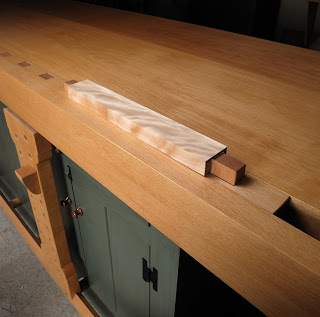

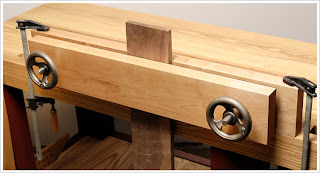




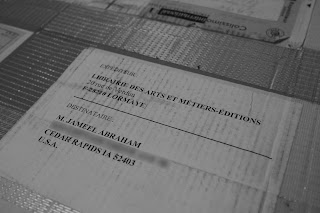








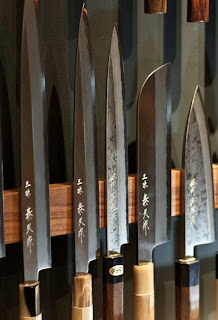


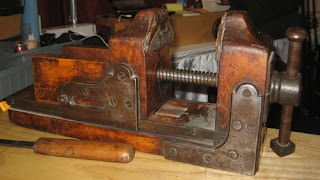
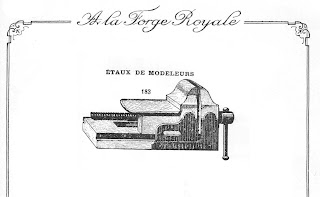
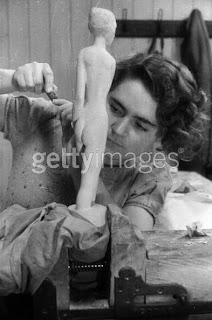
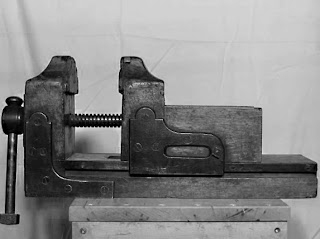

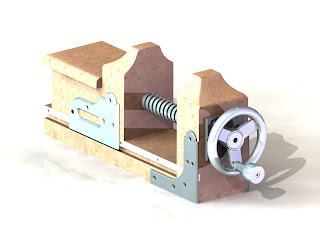
 Made in the U.S.A.
Made in the U.S.A.